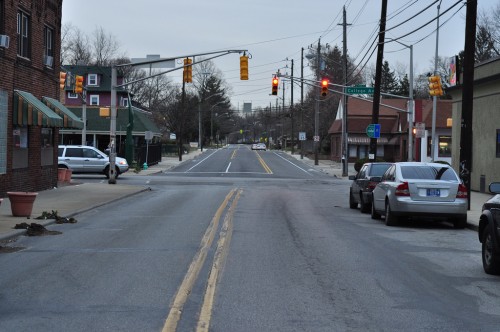
In the summer of 2010, the Indianapolis DPW began a project on 52nd street in Midtown Indianapolis. This project’s goal was to resurface the roadway, repair broken sidewalks and add bike lanes. This project was bounded by the Monon Trail on the east and by College Ave on the west. Last summer and fall, I brought you two stories here and here about this project. Previous projects east of the Monon on 52nd street had already added bike lanes and a smooth roadway. This project apparently falls under the Rebuild Indy banner although I am not positive as it seems like ALL DPW projects have the title of Rebuild Indy attached to them these days.
With that in mind, I set out recently to examine the work that they did and here is my critique of the design and execution of said project. Below is a general grade scale defined by pretty easy to follow criteria. I will attempt to justify my grade for each portion.
Grade Scale:
A – Excellent! No improvements needed
B – Great work. Some improvements needed
C– Status Quo
D – Borderline failure in design or execution
F – Total Failure in design or execution
Roadway
The previous roadway was removed and new asphalt laid down to replace it. It appears that two layers were added. One late in the fall of 2010 and another finishing layer recently. The finish is smooth and seems to blend well with the existing pavement as well as the transition with the Monon Trail. Those of us who live in this area had to endure some poor pavement conditions through the winter, but such is life. The DPW probably could have paved into each connecting street a few feet and made the transitions better, but otherwise, not bad.
Grade: C
Lane Width & Striping
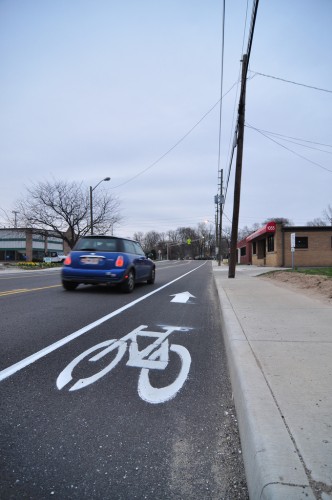
I took a tape measure with me so that I could determine whether or not the design narrowed the driving lanes. Since no additional ROW was acquired for this project it stands to reason that driving lanes took the brunt of this. Accordingly, I measured 9 feet for driving lanes. Compared to 9.5 to 10 feet further down 52nd street, I consider this a win. Additionally, due to the nature of the built environment through here whereby the home are much closer to the road, a sense of close proximity exists between drivers, cyclists and the abutting property. All these combined with the narrow lanes makes me believe that drivers may be encouraged to drive slower through this stretch. The bike lanes seem reasonable as well although I did not measure them. I always seem to think that we can do better here though and since no median was constructed to add landscaping, grass or pedestrian islands, I will not give an A.
Grade: B
Sidewalks & Utilities
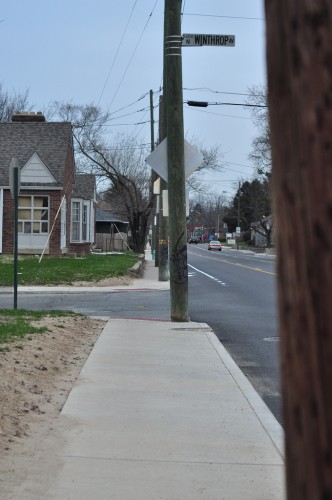
As I mentioned in the opening paragraph, part of this project was to rehabilitate the crumbling sidewalks. The previous conditions were unacceptable and while new concrete replaced the broken parts, the finished product is itself, unacceptable. This is due in part to the zero attention paid to the utility poles which are platted directly in the middle of most of the stretch of sidewalk. None of them were moved and new concrete was simply poured in around them. In previous posts, I measured and it appears that it is difficult to fit a wheelchair or stroller through some of the portion. Perhaps I am incorrect on this, but they look terrible and a pain to navigate around for those of lesser mobility.
Grade: F
ADA Ramps
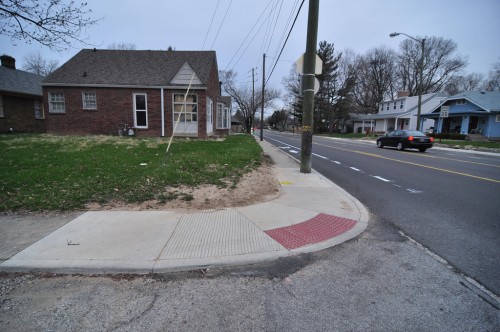
The addition of ADA ramps at all connecting streets was a welcome site. Proper rumble strips and bricks have been added to make this a pleasant experience for those needing them. However, coupled with the poor condition of the sidewalk, who is really going to be using these?
Grade: B
Conclusion
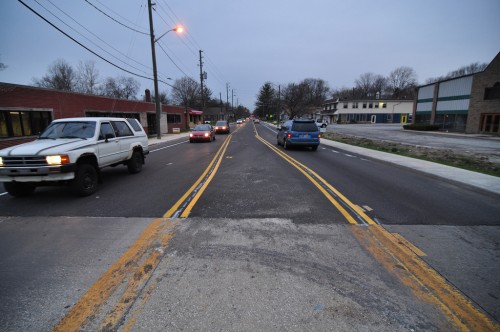
To wrap this up, I thought that I would share a short narrative. A couple of weeks ago, I traded barbs on twitter with Indianapolis Star columnist Matthew Tully about the Rebuild Indy program. He was propping it up and I questioned this logic based upon the notion that this funding could be used to tremendously improve the quality of our built environment which is sorely lacking in many areas. He accused me of being insane for questioning half a billion in infrastructure to which I replied, I’m not insane to question it if we are doing things incorrectly. This project is a key example of poor use of tax payer dollars. The sidewalks are unacceptable, the design of the road could have been improved, new pavement could have been extended to connecting streets and while the narrow driving lanes and addition of bike lanes save the project from being a total loss, when we as Indianapolis residents get to witness world class projects like the Cultural Trail and Georgia Street being built, well, I can’t help but demand more from our public works. How long until this pavement is pulled up at the seams where it is left unfinished on connecting streets? How long will it be until the utulity poles are relocated? And most importantly, how long will it be until people actually want to walk down a sidewalk like this?
As always, I am open to thoughts on my conclusions.
Of course the biggest problems with the RebuildIndy program are how it is funded and what projects they’re doing.
The city’s utilities was sold to another public entity, Citizen’s Gas. We owned it before and after the sale. Citizen’s, i.e. you and I funded the purchase by taking out a 30 year loan. Ballard is using that money from the 30 year loan to do short term improvement slilve paving. It’s like taking out a 30 year mortgage to buy a car.
I understand how it works Paul. It doesnt mean we can’t demand better projects for the money we are “borrowing”
This seems a little bitter. From looking at the third and fourth photo, it appears that there’s literally no more room to make the street wider or add a median or move the power poles. You can’t squeeze 30 feet of stuff into 28 feet of space. Where are you suggesting they put the poles?
I drove down this street last weekend and I thought it looked pretty good. I’m proud that the city is putting in bike lanes, even tho there aren’t many people using them right now. Hopefully as there are more and it becomes safe to ride in the city, they will get more use.
If I get an F in social studies, that doesn’t affect my A in math, yet you give the ADA ramps a B because the sidewalks aren’t good enough for you. It seems like this ‘report card’ is just a passive-aggressive way to say the poles in the sidewalks suck (which we agree that they do).
I will ackowledge that Scott. I am a little upset about the utility poles. A petition was launched last year to get the poles moved and it did not happen. Additionally, why is this middle lane there? I have lived in this neighborhood for 3 years now and NEVER seen the need for a middle lane. Would it not have benefitted the neighborhood to instead turn the middle lane into a landscaped pedestrian island? And I will continue to harp on the utility poles because frankly, they are positioned in the worst place possible. Sure the ADA ramps look good, but if you cant get a wheelchair on the sidewalk, what is the point? Same for strollers.
In the context of neighborhood renewal, a theme that it seems like everyone in Indy likes to talk about lately, this project fails to renew anyone’s faith that the city will indeed try to improve neighborhoods through infastructure that supports that message.
THAT is why I am passive aggressive about it. And I feel no shame in admitting that
Curt, I agree that this project is just some more half-assedness from the city. The poles in the sidewalk are a plague on our city. We have twin toddlers and hence a double stroller. I have to roll it off the curb, into the street, and back up the curb regularly because of the poles in the sidewalk. Oh how I would love some grass between the sidewalk and the street. Maybe put the poles there. Duh.
Instead of relocating poles, why not bury the lines? That seems like the most progressive approach.
I tend to agree with Curt, you probably don’t need a middle lane (not across the entire length of the street…maybe create middle lane stretches to avoid slow down where most vehicles turn left). Constructing a median (adding landscape…) or moving poles would make this project more expensive. But creating ADA ramps with sidewalks that are not fully accessible is money wasted.
However, I don’t agree with your overall grade. I think “Status Quo” grade is more appropriate.
I don’t know that much about construction, but it seems to me that the most cost effective way of “burying the lines underground” is to combine that work with other work underground. In other words, whenever they are fixing/replacing pipes on longer stretches, then the City should coordinate efforts and try to bury the electrical cables underground…maybe they are doing that already, but just a thought…
Sorry, Curt, I wasn’t contradicting you…just pointing out they should be donig long term projects given the 30 year loan we’ll be paying off. Your work though in examining the value of projects actually done is very much appreciated.
I don’t think the city should be allowed to use an excuse like the ROW isn’t wide enough. As stated earlier there is clearly a fairly wide strip of road inbetween each lane that could have been dedicated to either side of the street. DPW and INDOT always seem to find ROW for widening street projects so why should people who have chosen a lower impact mode of transportation be punished? INDOT just released its new road funding projections for 2010-2013. The total to simply add lanes or reconfigure work comes to a minor $7.2B. We wonder why nothing happens in terms of increased mobility for all users.
The theory is that some of these roads aren’t going to hold up all that well due to the quality of the asphalt. Amos Brown has been hitting that message home on his radio program all winter, usually saying “Who puts down asphalt in the cold????”.
My personal peeve about the Rebuild Indy project (the way the money was “obtained” is an entirely separate issue) is the bike lanes. There are some excellent bike lanes in the city. Hell, the one you show on 52nd looks to be one of the better ones. But the ones I often use downtown just seem to be the place where all kinds of debris end up, and the poor road conditions seem to affect the bike lanes the most.
The other thing is the wisdom of some of these projects. There’s an area of Pike Township that got some new sidewalk, but all thats there is a gas station and a small strip mall. not exactly a lot of pedestrians around. That money could’ve been used repairing some of the dilapidated sidewalks around downtown or in some of the neighborhoods.
Matt, because of the sidewalk ordinance, developers are compelled to build new sidewalks in commercial areas when they seek zoning approvals. That’s why there are sidewalks in front of the commercial buildings you reference. The city didn’t pay for them.
Not sure if it happened before or after these comments, but the City DPW actually came out and removed the sidewalk built in front of the strip mall just north of the Shell station at Michigan & 71st, which had been built by the developer as a commitment to a zoning approval. The DPW apparently didn’t like the sidewalk being separated from the street curb by a roughly five-foot grass buffer. So, they ripped out the developer’s investment in public infrastructure and used taxpayer money to rebuild a sidewalk right along the curb. That was definitely a few years ago, but unfortunately, they keep operating similarly in other places.
1. Paul, if DPW were borrowing money to patch potholes, your argument would make sense. But they’re not. Matching loan length to the life of the asset is not imprudent.
.
Sidewalks are 50-60 year (or more) improvements if built right. Even street repaving can be a long-term item. Kessler Blvd. E. Dr was repaved between Keystone and Allisonville in about 1991, and it is just now in poor enough shape to need it again. For those not paying attention, that’s a 20-year life span for pavement on a busy major thoroughfare. Likewise, Emerson Ave. between 38th & 56th was rebuilt last year, after having been substantially upgraded in the early 80s…a lifespan of nearly 30 years.
..
2. Nine-foot travel lanes are not wide enough for IndyGo busses and most trucks. The center-left-turn lane allows flexibility for wide vehicles as they pass bicyclists or turn in and out of side streets. Even in residential districts that’s necessary, as people move in and out and get deliveries from box and semi trucks.
I agree with what Matt is saying. When DPW rebuilds or flat out builds new sidewalks along busy through fares where people arent apt to walk anyway (because cars are flying by at 45mph) what is the point?
The money would be better spent creating sidewalks in neighborhoods that did not receive them in the years when sidewalks and pedestrian amenities were not a priority to politicians.
Good post, Curt!
A few items…
I agree with your grade (or lower) for the ADA ramps, but not because of the poles – instead it is apparent (and I live VERY close to here and use those bike lanes nearly every day) that the City did not adjust the grade properly where the new ramps went in. This makes for a little collection area where water and debris collect – significantly shortening the life of the road and sidewalk and making it unappealing at best.
9′ is perfectly wide enough for an IndyGo bus that is going 25 mph or so and there is ample room for turns.
A landscaped median would not have been possible due to the need for driveway and street access for left turns. Anything you could have put there would have been too broken up to look good or operate well. I personally would have liked to see no striped turn lanes giving the opportunity for passing (slowly) when someone is making a left. Doing this could have allowed a few more feet to move the lightpoles and maybe add a tree grate or two. BTW – to Mr. Barnett – it is an unsafe practice for the cyclist, the driver, and other drivers when a car travels out of their own space to pass a cyclist when there is a bike lane. Cyclists need 3′ to feel comfortable – not 3′ from the edge of the bike lane, but 3′ from their handlebar.
As for the RebuildIndy program, I would say don’t be overly quick to judge. There will be efforts started and funds spent over the next ten years from this program and the City is trying to think along lines that will generate more bang for their buck. I’m still not on board with all of their projects (probably not even the majority of them to this point), but some of the money could end up being spent with some good intentions and repercussions.
And, yes, the power poles are a travesty… as are the rest of them through the entire neighborhood!
Ben…you are incorrect about lane width needed for a bus. IndyGo says their bus measures at least 9.5 ft mirror to mirror. A driver can’t keep that in a 9-foot lane without encroaching on something constantly.
.
Your point about the bike lane is exactly the reason I was arguing to keep the center-left arrangement…so that wider vans, trucks, and IndyGo would have space to safely pass bicyclists without encroaching on the bike lane with vehicle, bumper, trailer or mirrors. In uncontrolled lane spaces (such as East 10th) where there is technically one lane each way but more than enough space to pass, vehicular traffic will almost always swing wide around a slower-moving bike, pedestrian, bus, or car that is near the curb.
.
Then there’s the emergency-vehicle exception: on a secondary arterial like 52nd, which serves as fire and ambulance access to neighborhood streets, there has to be enough pavement for those vehicles to pass traffic that stops or pulls to the curb. This is one of the faults of the East 10th Streetscape: there’s nowhere to go to get out of the fire truck’s way now.
All I can say is I would rather see 5 Rebuild Indy projects done right than 500 done wrong. The mentality that Indy streets just need to be cleaned up without considering pedestrians will cost a lot of money in the VERY NEAR FUTURE, trust me. Sidewalks should not be fiixed for utility poles…ONLY FOR HUMANS! I think the Rebuild Indy Program should focus on 1 or two larger areas or neighborhoods a year, then REAL PROGRESS could actually be noticed, giving people reason to live in our downtown/Midtown areas. An economic ‘domino affect’ with community infrastructure projects like these will not happen until the city becomes more focused.
They can quote their measurements all they want, but I know for a fact that the 9.5′ gives a little buffer room. That said, if it were a slightly wider lane (say 10.5′ – 11′), no center turn, and some green space next to the sidewalk area as I suggested, what would be the issue? Would have fixed the utility pole problem, and provided enough space for buses.
My issue with the ‘wide swing’ of cars passing is not that the intention is bad, but that it can do more harm than good. A moderately experienced cyclist is just fine with cars passing closely – the biggest problem is when the car makes a change in their path for the cyclist when it’s not necessary. This causes stress to the rider, the driver, and leads to accidents. On a two lane road if there is not room to pass, the cyclist should take the lane until there is room to pass or a good time pull off to let traffic pass. This is the same for bike lane road intersections in Indy as well where the bike lanes dies into a turn lane.
Good discussion – but at the end of the day we’re all saying the same thing: bike lane add = success; poles in the sidewalk = fail.
Interesting comments. I do give the city credit for seeing the need for the bikes lanes and putting them in place.
My two biggest concerns (aside from the poles) have not been mentioned.
First, the sidewalks are already crumbling. Not just a spot or two. There are sections where most of the surface has broken up. This concrete is less than a year old, and it is already failing. What is this going to look like in five years?
My main concern is from the perspective of a rider who is heading west from Keystone to College. As you approach the Monon your lane disappears. You are funneled into a tight gap that will not allow for a car and bike. Disappearing bike lanes are too common. But this one is flat out dangerous. The real shame is that this could have been corrected when the sidewalks were rebuilt. Moving the sidewalk three feet to the north a for about forty feet would have solved this problem.
I think there is routine maintenance and then projects done to encourage development. I agree in principle with Micah’s suggestion.
We could get more lasting investments that encourage private development with bolder, targeted projects. It seems that Rebuild Indy has focused mostly on routine maintenance projects, even if bike lanes are added.
I think that most value would come if there was a broader strategy for the Rebuild Indy dollars that was tied to better, dense development.
There is a $1billion-plus infrastructure deficit in Indianapolis, just for replacement of crumbling stuff. It’s REbuild Indy, not BUILD Indy, for that reason.
.
Otherwise, Curt would be complaining about crumbling and non-ADA compliant curbs and sidewalks (with utility poles in them) on 52nd, instead of new ones. 🙂
I would complain 😉
I realize that there is a backlog on fixing our built environment. This is a national epidemic. However, when a project like Rebuild Indy comes along, we should see this as a way to take advantage. To philosophically address what makes our current built environment a bad one. If we can leverage the money that is being thrown at the existing problems and improve them just a little bit, it will show that we are learning from the mistakes of the past. Face it, we live in an old city that is bleeding population. If we don’t use programs like Rebuild Indy, where else are we going to get the funds to create an environment that people want to live in? The Wal-Marts and Targets of the world arent going to fix our neighborhoods for us. This is a government issue.
I think you’re both right, Chris & Micah. I have heard rumors of a TIF district being established in the area of the 52nd Street bike lane add, for instance, and other rumors of a few potential larger job-creating projects (there are several available ripe parcels there). I hope that the resurfacing, sidewalks, and bike lanes serve to attract those projects and the TIF can put them over the top. I hope the City is thinking the same way – and on more than just this piece of the puzzle. Leveraging is what it’s all about. Time will tell.